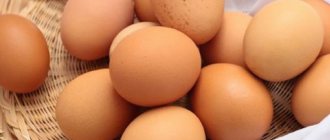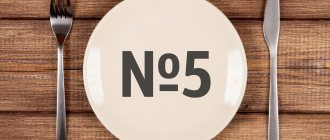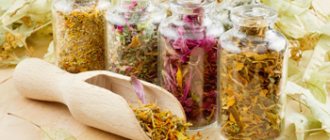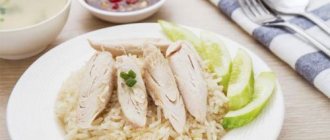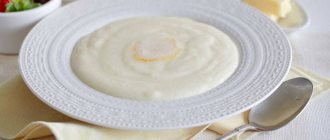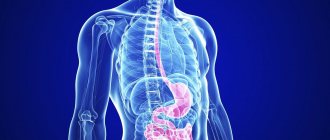Diseases of the gastrointestinal tract are becoming more common. This is primarily due to stress, poor diet, and frequent consumption of processed foods. Problems with bowel movements, bloating, epigastric pain and heartburn can be signs of a hiatal hernia.
Basic diet rules
If you follow certain nutritional rules, you should follow the advice of a nutritionist. Such recommendations are considered general. They will help avoid the following unpleasant sensations:
- Heartburn, burning sensation in the stomach.
- Belching with sour taste.
- The appearance of pain in the stomach.
The diet will also help reduce the intensity and frequency of manifestations of the disease; its main recommendations, according to many nutritionists, are as follows.
Table 1.
| What is allowed: | Eat healthy, properly prepared food. Take small portions, avoiding overeating. |
| What is prohibited: | Take fried, spicy, peppered, smoked foods. Avoid caffeine, chocolate, and baked goods made from refined flour. |
| Restrictions: | You can consume limited quantities of fermented milk products, low fat content, and weak tea. |
Alcohol, various sweets, and foods that promote fluid retention in the body, as well as increased gas formation, are also prohibited. Therefore, you should not include legumes, sugary carbonated drinks, fruits and vegetables rich in fiber in your diet.
The diet and recommendations for creating a menu are the prerogative of nutritionists or doctors monitoring the patient. The menu is individual for each person and consists of observing certain, specific rules that help normalize the digestion process.
Medical nutrition in the postoperative period
In the immediate postoperative period, it is necessary to establish parenteral nutrition for the patient. First of all, this concerns the introduction of energy substrates. The volume and composition of parenteral nutrition is determined individually depending on the patient’s needs.
Stabilization of the patient's condition and controlled diarrhea are indications for switching to nutrition using the gastrointestinal tract. This usually occurs 3-4 days after surgery. However, for large small bowel resections, some experts recommend starting enteral nutrition 2–4 weeks after surgery. In most clinical cases, standard mixtures for enteral nutrition are prescribed, however, for resections of the small intestine, it is advisable to use depolymerized nutrients (semi-element diets). Combined parenteral-enteral nutrition in the complex rehabilitation of patients after intestinal surgery can reduce the time and increase the effectiveness of rehabilitation treatment, significantly reduce the incidence of complications and adverse outcomes of the postoperative process.
If the patient’s condition improves, a transition to natural nutrition is recommended. However, it should be remembered that unreasonably early transfer of patients to natural nutrition after intestinal surgery significantly worsens the course of the recovery period, stimulates the development of enteral insufficiency syndrome, and disrupts the natural mechanisms of cavity and membrane digestion.
After artificial nutrition, patients are prescribed diet No. 0a. However, this diet is characterized by extremely low nutritional value (750-800 kcal) and the patient’s body experiences nutritional starvation during the entire time of its use. As a result, tissue repair mechanisms are significantly inhibited, creating conditions for the formation of an unfavorable course of the disease. Therefore, dietary treatment using diet No. 0a requires simultaneous parallel parenteral nutrition of patients.
If diet No. 0a is well tolerated and there is no diarrhea, after 2-3 days, patients should be transferred to diet No. 1a. It is prescribed for 2–4 days after diet No. 0a. However, if it is possible to carry out parenteral nutrition (transfusions of protein-energy mixtures) and in the presence of at least minimally severe diarrhea, the prescription of diet No. 1a should be postponed for several days.
If diet No. 1a is well tolerated, the patient is transferred to diet No. 1b.
Usually, by 14–15 days after intestinal surgery, the administration of basic diet No. 1 is recommended. In this case, the patient should adhere to the pureed version of the diet for a long time, even after transferring to outpatient treatment.
3-4 weeks after the patient is discharged from the hospital, a gradual transition to the unpureed version of diet No. 1 is required. The gradual transition from one diet option to another involves a daily reduction in the number of pureed dishes. Good tolerance of the introduced dishes is evidence of the normalization of the secretory and motor-evacuatory functions of the digestive system and allows for continued expansion of the diet.
If the dynamics are positive, after 5-6 weeks the patient is transferred to diet No. 15.
If milk is poorly tolerated, patients after intestinal surgery should avoid milk consumption for a long time (sometimes forever). Lactose overload in the presence of enzyme deficiency can aggravate secretory intestinal disorders. Thus, with the development of postoperative lactose deficiency in the diet of patients, whole milk should be limited as much as possible and for a long time. This applies to a lesser extent to the consumption of lactic acid products. Dairy products can be successfully replaced with soy products. Soy proteins are a very important source of additionally providing the body with highly plastic protein.
Authorized Products
The list of such should include:
Table 2.
| What can be consumed without restrictions: | Boiled chicken, turkey, veal or beef will also work. Provided that the meat is steamed. Stewed vegetables or baked in the oven. Porridges and soups, mostly pureed. You can eat rice, buckwheat, and wheat porridge. |
| In small quantities: | A little dried bread is allowed, literally a few pieces a day. Low-fat fermented milk products: natural yogurt, kefir. Weak tea without sugar. |
You can diversify your diet with fruits, which are easily digested and are regarded as an accessible source of vitamins and beneficial elements. The diet should be balanced, complete, exclude large amounts of glucose; light carbohydrates, which provoke the production of insulin in the body, are also prohibited.
Prohibited Products
Subject to any restrictions, you should avoid certain foods that can harm a person.
Table 3. What you can’t eat, list of prohibited foods:
| Strictly prohibited: | Not worth it: |
| Drinks with a high caffeine content, both hot and cold. Pork, bacon, lard and other fatty meats that take a lot of energy to process. Milk, because of lactose, is difficult for the body to digest and disrupts the functioning of the digestive system. Cabbage, mushrooms, as well as derivative dishes that contain these ingredients. Alcoholic drinks, because they irritate the mucous membranes of the stomach and intestines. Various marinated snacks, salads seasoned with rich sauce or mayonnaise. Smoked, salted, canned foods, semi-finished products and fast food. Sushi, pizza. You should not eat cucumbers and tomatoes, they contain a lot of water. | Fry food, marinate, seasoning generously with salt and spices. Use it half raw. |
All the products listed above can negatively affect the digestive process, aggravate unpleasant symptoms or cause their manifestations.
If a person suffers from a hiatal hernia, then following a diet will help him avoid serious digestive problems.
Information about the disease
Anatomically, the diaphragm, together with adipose tissue and ligaments, prevents the movement and protrusion of the abdominal organs:
- esophagus;
- intestinal loops;
- some parts of the stomach.
But there is a disease in which parts of the above organs are displaced through the esophageal opening into the upper abdominal cavity - this is a hiatal hernia.
The most common type is a sliding or axial hernia, in which the cardia, the sphincter between the stomach and the esophagus, is located above the esophageal opening of the diaphragm. This pathology is characterized by periodic displacement of the esophagus and upper part of the stomach into the chest cavity when overeating or adopting a horizontal body position. Therefore, the disease is accompanied by heartburn, sour belching, pain and bloating.
Sometimes there may be interruptions in the functioning of the heart and difficulty breathing. This is due to the displacement of organs from the abdominal cavity to the chest cavity. Such symptoms usually complicate the diagnosis.
The most reliable method of diagnosis is FGDS and X-ray examination with contrast.
There is also a paraesophageal hernia - it can have more serious consequences. Its treatment is carried out surgically in case of pinching. Congenital pathology, as well as displacement of the esophagus due to injury, is also one of the types of hernia that only a surgeon can correct. There is a classification of the disease according to its neglect:
- In the first stage, the fundus of the stomach touches the diaphragm.
- Second degree - the cardiac part (upper part) of the stomach is located in the esophageal opening.
- The most neglected. The esophagus and most of the stomach are located in the sternum.
Conservative treatment of a hiatal hernia without surgery is carried out only in the first two stages of the disease; it includes changing eating habits. In the third degree, medical care is carried out only surgically.
Measures to prevent constipation and gas formation with hiatal hernia
The accumulation of gases in the organs of the gastrointestinal tract during a hernia occurs due to compression, which is why it is so important not to eat foods that stimulate fermentation in the stomach and intestines. These include:
- legumes, including beans, peas, corn;
- drinks with a high content of sugar and gas, even if we are talking about highly carbonated mineral water, it is better to avoid it;
- vegetables and fruits rich in fiber;
- bakery products, pastries containing yeast, various desserts: affected or cakes;
- including bread-based drinks, such as kvass;
- You should not eat raw onions and garlic, radishes and radishes.
Proper nutrition and eating fresh fruits, vegetables and dairy products is an excellent prevention of constipation. Their occurrence will help prevent compliance with the diet, eating food in small portions.
Also, those who are afraid of constipation should not drink large amounts of liquid with food and lead a sedentary lifestyle.
Proper nutrition, combined with physical activity, is a good method for preventing constipation and disorders of the digestive system.
Living with a hiatal hernia
The occurrence of a hiatal hernia is often associated with excess weight. Therefore, it is important for patients to first normalize their weight and prevent it from increasing.
The pathology can lead to significant discomfort if left untreated. In order to alleviate the condition, you need to follow simple recommendations:
- eat a varied and balanced diet;
- give preference to thermally processed vegetables and fruits without coarse fiber;
- give up junk food: fast food, fatty, spicy and smoked foods will only make you feel worse;
- follow a healthy lifestyle: smoking and alcohol have a bad effect on the functioning of the gastrointestinal tract;
- do not lie down after eating - this leads to a deterioration in the general condition and progression of the hernia;
- take time to exercise - moderate physical exercise strengthens the ligamentous apparatus.
A sliding hiatal hernia is not a death sentence; you can live with it your whole life and not even notice it if you follow a diet and exercise. But the lack of treatment is dangerous - the hernia can progress and become pinched, then only surgery will help.
Menu by day for the week
You can compose it yourself, following the recommendations given by the doctor. This way you will be able to diversify your diet with your favorite foods and avoid strict food restrictions.
Table 4. Menu for the week
| Day of the week: | Breakfast: | Dinner: | Dinner: |
| On Monday we will eat: | Baked apples, tea with grain bread and jam. | Cottage cheese seasoned with natural yogurt, a little honey. | Oven-baked or steamed fish, boiled potatoes. |
| On Tuesday: | Oatmeal with milk, a little jam and fruit, tea. | Pumpkin puree soup, boiled chicken fillet. | Bananas with kefir, a little low-fat cottage cheese. |
| On Wednesday you can treat yourself to: | A cup of green tea with honey and 2-3 sandwiches with rye bread and low-fat cheese. | Turkey or chicken with pasta. Salad of grated apple and carrots with natural yogurt. | Fruit jelly, baked apples, banana, cottage cheese casserole. |
| On Thursday: | Cottage cheese with fruit, a cup of tea with oat cookies, or cheesecakes. | Steamed vegetables, fish or some veal. | Vegetable casserole, a glass of kefir. |
| On Friday we will eat: | Rice porridge, toast with jam, tea. | Stewed zucchini with smoked fillet. Fresh vegetable salad with cheese. | 2 boiled eggs, apple juice or a glass of natural yogurt. |
| On Saturday we will prepare: | Omelette, tea with baked apples or dried fruits. | Buckwheat cooked in water with chicken or turkey. Vegetable salad. | Cottage cheese with fruit, maybe a little tea with honey. |
| On Sunday: | Sandwiches with cheese, rice or oatmeal porridge cooked in milk. | Stewed with veal or beef, zucchini. Spinach puree soup. | Tea with toast and jam. Grated carrot salad with apple. |
Fully or partially limited products
- Fatty and stringy meat, fatty duck and goose, meat and fish broths, canned food, smoked meats, pickled vegetables.
- Fried dishes, mushroom decoctions, tomato and mushroom sauces, fish and meat stewed in their own juices.
- Fresh bread and pastry.
- Tomatoes, radishes, white cabbage, sorrel, cucumbers, onions, mushrooms, sour fruits and berries.
- Spices and seasonings.
- Millet, barley and pearl barley cereals, pasta, legumes.
- Fermented milk products with high acidity.
- Carbonated drinks, sour juices.
The list of products may expand due to individual poor tolerance. Foods that cause heartburn , epigastric discomfort, and vomiting should be avoided.
Table of prohibited products
| Proteins, g | Fats, g | Carbohydrates, g | Calories, kcal | |
Vegetables and greens | ||||
| vegetables legumes | 9,1 | 1,6 | 27,0 | 168 |
| canned vegetables | 1,5 | 0,2 | 5,5 | 30 |
| radish | 1,2 | 0,1 | 3,4 | 19 |
| white radish | 1,4 | 0,0 | 4,1 | 21 |
| black radish | 1,9 | 0,2 | 6,7 | 35 |
| turnip | 1,5 | 0,1 | 6,2 | 30 |
| asparagus | 1,9 | 0,1 | 3,1 | 20 |
| tomatoes | 0,6 | 0,2 | 4,2 | 20 |
| horseradish | 3,2 | 0,4 | 10,5 | 56 |
Berries | ||||
| grape | 0,6 | 0,2 | 16,8 | 65 |
| gooseberry | 0,7 | 0,2 | 12,0 | 43 |
| currant | 1,0 | 0,4 | 7,5 | 43 |
Cereals and porridges | ||||
| corn grits | 8,3 | 1,2 | 75,0 | 337 |
| pearl barley | 9,3 | 1,1 | 73,7 | 320 |
| millet cereal | 11,5 | 3,3 | 69,3 | 348 |
| barley grits | 10,4 | 1,3 | 66,3 | 324 |
Flour and pasta | ||||
| pasta | 10,4 | 1,1 | 69,7 | 337 |
Bakery products | ||||
| vysivkovy bread | 9,0 | 2,2 | 36,0 | 217 |
| oatmeal bread | 10,1 | 5,4 | 49,0 | 289 |
| bran bread | 7,5 | 1,3 | 45,2 | 227 |
| whole grain bread | 10,1 | 2,3 | 57,1 | 295 |
Confectionery | ||||
| jam | 0,3 | 0,2 | 63,0 | 263 |
| candies | 4,3 | 19,8 | 67,5 | 453 |
Ice cream | ||||
| ice cream | 3,7 | 6,9 | 22,1 | 189 |
Raw materials and seasonings | ||||
| mustard | 5,7 | 6,4 | 22,0 | 162 |
| ketchup | 1,8 | 1,0 | 22,2 | 93 |
| mayonnaise | 2,4 | 67,0 | 3,9 | 627 |
| ground black pepper | 10,4 | 3,3 | 38,7 | 251 |
| chilli | 2,0 | 0,2 | 9,5 | 40 |
| tomato sauce | 1,7 | 7,8 | 4,5 | 80 |
| spicy tomato sauce | 2,5 | 0,0 | 21,8 | 98 |
Dairy | ||||
| kefir | 3,4 | 2,0 | 4,7 | 51 |
| sour cream | 2,8 | 20,0 | 3,2 | 206 |
| curdled milk | 2,9 | 2,5 | 4,1 | 53 |
Sausages | ||||
| dry-cured sausage | 24,1 | 38,3 | 1,0 | 455 |
Bird | ||||
| smoked chicken | 27,5 | 8,2 | 0,0 | 184 |
| duck | 16,5 | 61,2 | 0,0 | 346 |
| smoked duck | 19,0 | 28,4 | 0,0 | 337 |
| goose | 16,1 | 33,3 | 0,0 | 364 |
Fish and seafood | ||||
| dried fish | 17,5 | 4,6 | 0,0 | 139 |
| smoked fish | 26,8 | 9,9 | 0,0 | 196 |
| canned fish | 17,5 | 2,0 | 0,0 | 88 |
Oils and fats | ||||
| creamy margarine | 0,5 | 82,0 | 0,0 | 745 |
| animal fat | 0,0 | 99,7 | 0,0 | 897 |
| cooking fat | 0,0 | 99,7 | 0,0 | 897 |
Non-alcoholic drinks | ||||
| green tea | 0,0 | 0,0 | 0,0 | — |
| black tea | 20,0 | 5,1 | 6,9 | 152 |
| * data is per 100 g of product | ||||
Diet after hiatal hernia surgery
People who have undergone surgery are advised to adhere to strict dietary restrictions; it is better to avoid all foods that can cause serious harm to the body.
More often, doctors recommend the following diet for those who have recently undergone surgery:
- You can eat broths, as well as porridges with water in the first three days; jelly and water, kefir with a low percentage of fat content are allowed.
- After the specified time, it is allowed to eat pureed food, and gradually the patient is accustomed to solid foods.
The doctor decides how long the recovery will last, it all depends on the normalization of the functioning of the organs of the gastrointestinal tract.
Much depends on the method of surgical intervention; if the hernia was removed by laparoscopic surgery, then recovery will take from 3 to 5 days. The patient will be given nutritional advice and sent home.
Surgical intervention requires a long recovery and is fraught with complications, so it is difficult to predict exactly when the patient will be allowed to return to their usual diet. On average, this takes from 10 to 14 days.
Reviews and results
The diet is expanded compared to Diets 1A and 1B and can be performed for a long time, as it contains the physiological norm of nutrients. Reviews from patients indicate that this diet, and especially split meals, has a beneficial effect on the condition of the esophagus and stomach: discomfort, belching and heartburn, and heaviness in the chest are eliminated.
- “... I don’t want to operate on a hernia, but frequent reflux of acidic contents caused inflammation of the esophagus without erosion. I decided that it was better to be careful (not to lift weights, etc.) and to be on medical nutrition than to have surgery right away. I adhered to it very strictly for 3 months, then expanded it a little, as my health became normal. I excluded dishes and foods that cause heartburn (lemon and all sour fruits, pickles, sweets, honey, jam). I watch my diet and take pills. I lost 5 kg in 4 months”;
- “... The hernia has been there for many years, but it does not increase and is not strangulated. Recently, heartburn began to bother me often, I was examined, and during gastroscopy they discovered superficial erosions in the esophagus. I was treated in the hospital for 3 weeks, here Table 1 B was prescribed. During the control gastroscopy, the erosions healed. At home I switched to Table 1 and observed it with all strictness for 3 months. In addition, I monitored the condition and studied the tolerance of certain foods and excluded them additionally. I'm used to steamed cutlets and meatballs, but I can eat many porridges and mashed potatoes. Sometimes I want fatty and fried foods, but I can’t have them - I immediately get heartburn and discomfort in the chest. I realized that with my illness, nutrition is the main thing”;
- “... The hernia had to be operated on because there were complications. I was in the hospital for 2 weeks, I was on diet food 1A, but more pureed meat dishes; at home I began to follow this table. They warned not to overeat and to stick to the diet for as long as possible. The work does not involve hard work, so I have enough food, I can withstand the restrictions well, especially since I need to lose another 7 kg. True, it’s inconvenient to carry dietary dishes to work, but you have to put up with it.”

